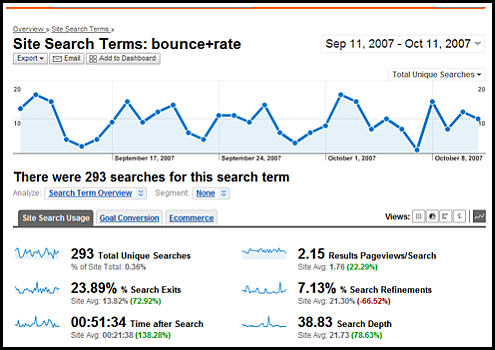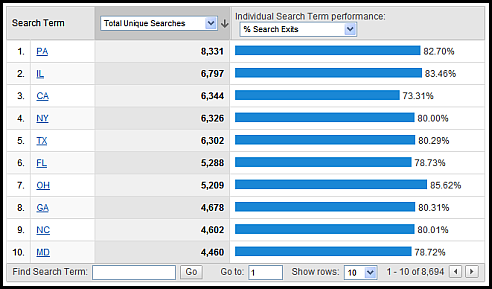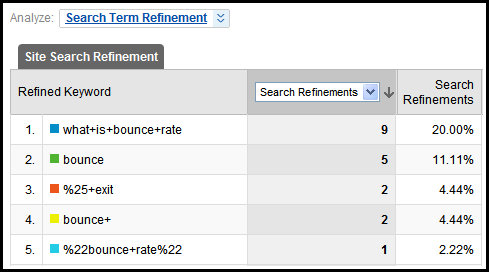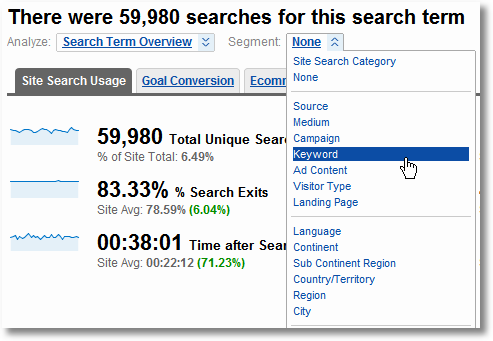Kick Butt With Internal Site Search Analytics
- Fahad H

- Oct 16, 2007
- 7 min read
I love Internal Site Search data.
It is a amazing peek into customer intent, which usually is quite elusive in our normal clickstream data.
I had first written about the wonders of site search analysis in a June 2006 post: Are You Into Internal Site Search Analysis? You Should Be. It is also covered in detail in Web Analytics: An Hour A Day.
Google Analytics's launch of internal site search analysis today is a great excuse to revisit the world of site search.
You should really care about analyzing searches people do on your website because it has become the most used navigation feature on your website. You can of course understand a lot better what people are looking for (intent) but more importantly you can see if the website is delivering.
This post is using screenshots of the new Google Internal Search Analysis reports but the process of understanding the search data will apply to all companies. Even if you are not using Google Analytics you should be able to do all this with Omniture or Visual Sciences or HBX or WebTrends or CoreMetrics etc etc etc.
For your website if you analyze internal site search using tips provided in this blog post then your salary will increase by $10,000 in 12 months , because based on the insights from these reports conversion rate and customer satisfaction score will improve and the result will be a incremental $1.5 million dollars of revenue for your company. (Yes life is not fair, you deserve a bigger cut!)
Five Steps to Internal Search Analytics Nirvana:
# 1: Understand Site Search Usage.
# 2: Where Do Site Visitors Search?
# 3: Measure Internal Site Search Quality.
#4: Three Words: Segment, Segment, Segment!
# 5: Life Is About Results: Measure Outcomes!
Intrigued? Here are specific details of how to measure each of the five steps and be on your way to internal search measurement heaven (and remember there is a salary increase in this for you!)……
[Click on the images below to see higher resolution versions!]
# 1: Understand Site Search Usage.
Most people hugely underestimate how many people use Internal Search. So the first step is simple. Just get that number!

Now sit back and relax and marvel in the knowledge that you know exactly how many people are using site search and your are on the cusp of understanding what are people looking for!
Next thing you want to know in terms of usage is what are people searching for? Here you go….

Now that you know how much internal search is used and which keywords are important, it is time to dive deep to understand the holistic story of individual keywords. Its time for pretty pictures that teach….

You can see the trend, you can also see some of the key new metrics that tell you the whole story (more on them later).
In less than two minutes you now have a solid understanding of the most used navigation elements on your site and areas of improvement.
# 2: Where Do Site Visitors Search?
Home pages are dead. We all know that by now. Traffic to your site lands deep into your website, at a location determined by Google, Yahoo and MSN. That begs this question:
What's your first impression and is it delivering for your customers?
A new weapon in your understanding of that is this report…..

Often it is extremely difficult to find reports that provide you this information easily. Where in God's name are all those people searching? Now you know.
This information is helpful in giving key context to understanding how well content on a page is delivering value. Ideally if the page is working then there should not be a need for people to search. Ideally.
Now you can go to these pages, see what people are searching for and gain ideas of potential fixes or multivariate tests to improve page performance .
There is also a new report that shows you the top pages viewed as a result of being shown in your search results. Look for your Internal Search Destination Pages report.
This next report is my favorite of the bunch. I think you are going to absolutely love it as well.
It is the Search Navigation report and for a particular keyword and for that keyword it shows you the web pages on which people did the internal search AND then where they ended up on your website.
You would think no matter where I search for the keyword "new campaign" that I would end up on the same page from search results, not even close!

You get a in depth understanding of visitor behavior, where they start looking, what are they looking for and why did they all end up on a obscure page on your website. :) So you go back to the start page and try so understand customer intent and then see how you can improve search performance.
It is obvious to you how the above report can also help you measure the quality of your internal search results. Let's look at some other reports that do that even more directly.
# 3: Measure Internal Site Search Quality.
Remember sexy metric bounce rate? The GA team has kindly built my beloved bounce rate metric for Internal Search. Its called % Search Exits.
The phenomenon is still the same: "They came, they search on your site, they puke at your search results, they leave from the search results page ".

Some of you have heard me present the concept of the finding your key metrics a "best friend" to make data "instantly useful". The above is a example of that.
The two best friends above Unique Searches and % Search Exits help you know what's being searched but also what search results stinks (the ones with high exit rates from search results).
Knowing what is being searched is ok, knowing then where to focus your efforts to improve is priceless .
Here one more I think you'll find handy: Number of search results pages viewed for each key word !

The hypothesis being that if you provide the most relevant results then people will click on the "golden triangle" on the first page and be on their way. This shows you where it is not happening and people have to dig to find relevant results. Look at #7 OH. Search results need fixing!
One last search quality report. Refinement .
After people search for the keyword "bounce rate" what do they search for next?

If you provide relevant results you reduce the likelihood that people have to search again. This report is critical in helping you understand very specifically what Visitors are looking for.
Imagine knowing what people search on amazon after they search for ipod? Or on a ecommerce website do people really search for diapers after they have searched for beer? :)
As I looked across data for different sites I found this report to be endlessly fascinating. It's like people are talking to you!
#4: Three Words: Segment, Segment, Segment!
Do we love segmentation or what? If you want actionable insights you need to segment like crazy.

In the above view I am about to segment on something delightful: What was the keyword that brought you to my website and then what did you search for!
Imagine a search keyword funnel you could create: Keyword searched on Google / Yahoo -> Keyword searched on Internal Site Search -> Keyword Refinement. Nice.
Here's a more straight forward one comparing site search usage, exits, refinement and, this is new, time spent on site After doing a internal site search ……

In most GA internal search report now you can compute "lift" that internal site search provides. Say you are a content site, you want people to spend time on your site, does your internal search deliver relevant results and engage (yes I said engage!) Visitors with your site?
The above report gives you that answer (and it is segmented to boot).
# 5: Life Is About Results: Measure Outcomes!
With the press of two buttons you can measure conversion rate of visitors who use Internal Site Search…

(Please click on the above image to see the high rez version, this site does internal search so well that if people search on the site then the conversion rate is 21% compared to 3.6% for those that don't!)
I can't actually show revenue numbers but I wanted to share a screenshot that illustrates how revenue reporting would look like when you log into Google Analytics to analyze the Internal Search data…..

You can easily report on Revenue, Average Order Size, Conversion Rate and Per Visit Value . This will empower you to put hard numbers in front of your executives that will help you justify resources.
That's it, five simple ways in which you can gain a comprehensive understanding of the performance of the search engine on your website.
Every report you have seen in this blog post is between three to five clicks after you log into the tool. That's it. Three to five clicks.
And to make things even easier for novices or experts the Internal Site Search Dashboard now offers you a brand spanking new way to navigate your reports , via questions…..

All you do is login and pick the question you want answered.
So is there something missing. Yes. The missing. Its missing. :)
The one report you don't get out of the box is the one that shows keyword searches that return no results from your internal search engine. This is important to know, but in the grand scheme of things I have come to believe that people place way too much importance on this report. It results in a small obsession which takes focus away from solving for the kinds of things you have read above, real actionable stuff.
You can still get keywords with zero results returned, for example using the new event logging model also announced today. But I do encourage you to not obsess overtly about it right away.
(Two other things were announced today: Event Logging & Outbound Link Tracking. Both super features. Of the two I think Event Logging will have a massive impact, now you can capture data in a clean and scalable way from any fluid experience – ajax, flex, flash, videos, etc – and you can capture any data that your analytics tool could not capture cleanly (goals, clicks, impressions, submissions, anything really). GA becomes only the second tool that does true event logging. So many ways to use it, but that's a story for another day. Do check it out.)
Ok now its your turn.
Please share your perspectives, critique, additions, subtractions, bouquets and brickbats via comments. Thank you.
[Like this post? For more posts like this please click here, if it might be of interest please check out my book: Web Analytics: An Hour A Day.]








Comments